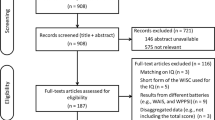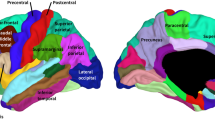Abstract
This paper relates the early work of Samuel Orton on cerebral dominance to the current neuropsychological concept of laterality as reciprocal functions of the two cerebral hemispheres. The genetic-cultural perspectives of laterality and functional asymmetry in relation to learning disorders are discussed. A balanced and integrative view of the cognitive contribution of the two hemispheres is needed.
Similar content being viewed by others
References
Annett, M. 1964. A model of the inheritance of handedness and cerebral dominance.Nature:59–60.
Annett, M. 1967. The binomial distribution of right, mixed and left handedness.Quarterly Journal of Experimental Psychology 19:327–333.
Annett, M. 1970. A classification of hand perference by association analysis.British Journal of Psychology 61:303–321.
Annett, M. 1974. Handedness in the children of two left handed parents.British Journal of Psychology 65:129–131.
Annett, M. 1976. A co-ordination of hand preference and skill replicated.British Journal of Psychology 67:587–592.
Annett, M. 1981. The right shift theory of handedness and developmental language problems.Bulletin of the Orton Society 31:103–121.
Bakker, D. J. 1979. Hemispheric differences and reading strategies: Two dyslexias?Bulletin of the Orton Society 29:84–100.
Bemporad, B., and Kinsbourne, M. 1983. Sinistrality and dyslexia: A possible relationship between subtypes.Topics in Learning and Learning Disabilities 3 (1):48–65.
Benton, A. L. 1977. Reflections on the Gerstmann syndrome.Brain and Language 4:45–62.
Bradshaw, J. L. 1980. Right hemisphere language: Familial and non familial sinistrals, cognitive deficits and writing hand position in sinistrals, and the concrete-abstract, imageable-nonimageable dimensions in word recognition. A review of interrelated issues.Brain and Language 10:172–188.
Briggs, G. G., and Nebes, R. D. 1976. The effects of handedness, family history and sex on the performance of a dichotic listening task.Neuropsychologia 14:129–134.
Chall, J., and Mirsky, A. F. (eds.). 1978.Education and the Brain. Chicago: University of Chicago Press.
Corballis, M. C. 1980a. Laterality and myth.American Psychologist 35:284–295.
Corballis, M. C. 1980b. Is left-handedness genetically determined?In J. Herron (ed.).Neuropsychology of Left-handedness. New York: Academic Press.
Corballis, M. C., and Beale, I. L. 1971. On telling left from right.Scientific American 224:96–104.
Corballis, M. C., and Beale, I. L. 1976.The Psychology of Left and Right. Hillsdale, NJ: Erlbaum.
Critchley, M. 1970.The Dyslexic Child. London: Heinemann.
Dawson, J. L. M. B. 1977. An anthropological perspective on the evolution and lateralization of the brain.In S. J. Dimond, and D. A. Blizard (eds.).Evolution and Lateralization of the Brain. New York: New York Academy of Sciences.
Fischer, F. W., Liberman, I. Y., and Shankweiler, D. 1977. Reading reversals and developmental dyslexia: A further study.Haskins Laboratories Status Report on Speech Research SR-51/52:75–89.
Fletcher, J. M., Satz, P., and Morris, R. in press. The Florida longitudinal project: Theoretical implications.In S. A. Mednick, and M. A. Harway (eds.).U. S. Longitudinal Projects. New York, NY: Cambridge University Press.
Geschwind, N. 1975. The apraxis: Neural mechanisms of disorders of learned movement.American Scientist 63:188–195.
Geschwind, N. 1982. Why Orton was right.Annals of Dyslexia 32:13–30.
Geschwind, N., and Behan, P. 1982. Left-handedness: Association with immune disease, migraine, and developmental learning disorder.Proceedings of the National Academy of Sciences 79:5097–5100.
Hardyck, C., and Petrinovich, L. F. 1977. Left handedness.Psychological Bulletin 84:405–411.
Herron, J. (ed.). 1980.Neuropsychology of Left-handedness. New York, NY: Academic Press.
Hertz, R. 1973. The preeminence of the right hand: A study in religious polarity.In R. Needham (ed.).Right and Left: Essays on dual symbolic classification. Chicago: University of Chicago Press.
Hines, D., and Satz, P. 1971. Superiority of right visual half-fields in right handers for recall of digits presented at varying rates.Neuropsychologia 9:21–25.
Hines, D., and Satz, P. 1974. Cross modal asymmetries in perception related to asymmetry in cerebral function.Neuropsychologia 12:239–247.
Kinsbourne, M., and Warrington, E. K. 1963. Developmental factors in reading and writing backwardness.British Journal of Psychology 54:145–156.
Kinsbourne, M., and Warrington, E. K. 1966. The developmental Gerstmann syndrome.In J. Money (ed.)The Disabled Reader: Education of the dyslexic child. Baltimore: Johns Hopkins Press.
Lashley, K. S. 1938. The mechanism of vision: XV. Preliminary studies of the rat’s capacity for detailed vision.Journal of General Psychology 18:123–193.
Leong, C. K. 1980. Laterality and reading proficiency in children.Reading Research Quarterly 15:185–202.
Levy, J. 1969. Possible basis for the evolution of lateral specialization of the human brain.Nature 224:614–615.
Levy, J., and Gur, R. C. 1980. Individual differences in psychoneurological organization.In J. Herron (ed.).Neuropsychology of Left-handedness. New York, NY: Academic Press.
Liberman, I. Y., Shankweiler, D., Orlando, C., Harris, K. S., and Berti, F. B. 1971. Letter confusions and reversals of sequence in the beginning reader: Implications for Orton’s theory of developmental dyslexia.Cortex 7:127–142.
Luria, A. R. 1970.Traumatic Aphasia: Its syndromes, psychology and treatment. The Hague: Mouton.
Mattis, S., French, J. H., and Rapin, I. 1975. Dyslexia in children and young adults: Three independent neuropsychological syndromes.Developmental Medicine and Child Neurology 17:150–163.
Nebes, R. D. 1977. Man’s so-called minor hemisphere.In M. C. Wittrock, J. Beatty, J. E. Bogen, M. S. Gazzaniga, H. J. Jerison, S. D. Krashen, R. D. Nebes, and T. J. Teyler.The Human Brain. Englewood Cliffs, NJ: Prentice-Hall.
Orton, S. T. 1925. “Word blindness” in school children.Archives of Neurology and Psychiatry 14:581–615.
Orton, S. T. 1928. Specific reading disability—Strephosymbolia.Journal of the American Medical Association 90:1095–1099.
Orton, S. T. 1937.Reading, Writing, and Speech Problems in Children. New York, NY: Norton.
Pirozzolo, F. J. 1979.The Neuropsychology of Developmental Reading Disorders. New York, NY: Praeger.
Ratcliff, G., Dila, C., Taylor, L., and Milner, B. 1980. The morphological asymmetry of the hemispheres and cerebral dominance for speech: A possible relationship.Brain and Language 11:87–98.
Satz, P. 1976. Cerebral dominance and reading disability: An old problem revisited.In R. M. Knights, and D. J. Bakker (eds.).The Neuropsychology of Learning Disorders: Theoretical approaches Baltimore: University Park Press.
Satz, P. 1979. A test of some models of hemispheric speech organization in the left- and right-handed.Science 203:1131–1133.
Satz, P., Taylor, H. G., Friel, J., and Fletcher, J. 1978. Some developmental and predictive precursors of reading disabilities: A six year follow-up.In A. L. Benton, and D. Pearl (eds.).Dyslexia: An appraisal of current knowledge. New York, NY: Oxford University Press.
Shankweiler, D., and Liberman, I. Y. 1972. Misreading: A search for causes.In J. F. Kavanagh, and I. G. Mattingly (eds.).Language by Ear and by Eye. Cambridge, MA: MIT Press.
Smith, I. M. 1964.Spatial Ability: Its educational and social significance. London: University of London Press.
Sperry, R. W. 1970. Cerebral dominance in perception.In F. A. Young, and D. B. Lindsley (eds.).Early Experience and Visual Information Processing in Perceptual and Reading Disorders. Washington, D.C.: National Academy of Sciences.
Sperry, R. W. 1982. Some effects of disconnecting the cerebral hemispheres.Science 217:1223–1226.
Springer, S. P., and Deutsch, G. 1981.Left Brain, Right Brain. San Francisco, CA: W. H. Freeman.
Sutherland, N. S. 1960. Visual discrimination of orientation by octopus: mirror images.British Journal of Psychology 51:9–18.
Teng, E. L., Lee, P.-H., and Yang, K.-S. 1979. Lateral preferences for hand, foot and eye, and their lack of association with scholastic achievement in 4143 Chinese.Neuropsychologia 17:41–48.
Teng, E. L., Lee, P.-H., Yang, K.-S., and Chang, P. 1976. Handedness in a Chinese population: Biological, social, and pathological factors.Science 193:1148–1150.
Zangwill, O. L. 1960.Cerebral Dominance and its Relation to Psychological Function. Edinburgh: Oliver and Boyd.
Zurif, E. B., and Bryden, M. P. 1969. Familial handedness and left-right differences in auditory and visual perception.Neuropsychologia 7:179–187.
Author information
Authors and Affiliations
Additional information
This is a modified version of an address given at the Spring Conference of the Upper Midwest Branch of The Orton Dyslexia Society in Minneapolis-St. Paul, Minnesota, April, 1982.
Rights and permissions
About this article
Cite this article
Leong, C.K. Confessions of a schoolman—On dyslexia and laterality. Annals of Dyslexia 34, 15–27 (1984). https://doi.org/10.1007/BF02663611
Issue Date:
DOI: https://doi.org/10.1007/BF02663611




